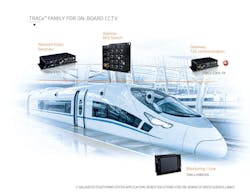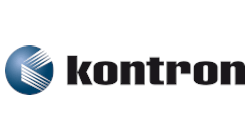Helping Mass Transit Become More Secure: COTS Platforms Enable Smarter, Real-Time Video Surveillance
To keep passengers, employees, equipment and infrastructure safe, it is incumbent on transit agencies to implement the highest protection methods possible. Video surveillance is viewed as a key part of an effective security system. Beyond its security use, video surveillance can also help improve operator efficiency, cut costs and enhance the overall passenger experience by reducing delays or disruptions to service from unforeseen mechanical breakdowns, track obstructions or just traffic congestion. There is almost uniform agreement that video surveillance is considered essential to monitor and capture clear incident images that can protect passengers and assets while keeping operations running smoothly.
Hampering security system advancements are current fragmented, proprietary video surveillance technology solutions. These closed-legacy proprietary technologies don’t provide the necessary interoperability between various components and applications within a video surveillance system preventing operators from maximizing or expanding their infrastructure investments. It also severely limits them from migrating to newer technologies and impedes the ability to easily customize designs when a transit agency’s needs change.
Making the Leap to Newer Technologies
Technologies for streaming video, high resolution and CCTV cameras, video analytics, real-time passenger information and detection systems and the advanced network bandwidth to connect them all have made tremendous leaps in recent years enabling clearer viewing for quicker incident decisions that is an incentive for transit agencies to update outdated security equipment.
Advanced video surveillance system building blocks based on open computing architectures are the enabling platforms that support newer video surveillance capabilities. They facilitate cost-effective development and deployment while at the same time help reduce costs and shorten complex integration times. Using commercial off-the-shelf (COTS) -based platforms enable operators to configure computing performance based on their needs — from lower end single-core processor systems to integrating multi-core processors for higher performance requirements. They also start to put an end to market fragmentation that causes development costs to continually rise and stifle industry growth.
Many of the latest COTS building block platforms are designed with a uniform architecture based on common application programming interfaces (APIs) making it much easier for developers to build or test their video surveillance solutions. Open industry standards also make it easier to interact with third party systems that are sure to be required when broadening the scope of a video surveillance system.
Extending Video Surveillance Usage
Helping ensure video surveillance technologies are increasingly more effective and interoperable to handle advanced capabilities are open architecture platforms that are verified with video management software (VMS) that support the ONVIF global standards for the interface of IP-based security products.
Analytics from adaptive and smart video surveillance is anticipated to be very high amongst public transport organizations in the coming years. The integration of new video analytics and remote monitoring technologies multiplies the interfaces that operators must manage. This increased interface complexity may make the efficient management of emergencies more difficult if video surveillance systems are not based on standards-based technologies.
A significant COTS-based building block for video surveillance is network video recorders (NVRs), which is a device that digitally records video data, audio data and its associated metadata. NVRs are essential design elements helping developers easily incorporate technologies that help manage the full range of video equipment, multiple cameras and vehicle activity through a single software solution. Streamlining processes and imaging access through a central infrastructure device is a powerful tool to strengthen security.
Working in conjunction with NVRs are new VMS features that manage video, audio and associated metadata recordings that offer many configurable parameters to dynamically control the behavior of the recorder. VMS allows operators to view live and recorded audio and video sequences, provides alarm monitoring and post-event analysis while also supporting encryption of the audio and video data at the time of recording. IP-based, today’s advanced VMS offer ONVIF-supported interoperability making them compatible with a diverse range of cameras and the latest network video encoding and streaming protocols.
A real-world example of an entirely IP-based on-board video surveillance system is the collaboration between Kontron and Adetel Solution. Supporting a wide variety of cameras and utilizing the latest generations of network video encoding and streaming protocols, it incorporates Adetel Solution’s VMS and multiple high-resolution cameras including a full HD vandal-resistant network mobile flat camera. The whole system is powered by a Kontron TRACe V304-TR NVR to provide a full onboard train central management solution. It enables captured video images from different cameras and audio signals to be digitized, compressed and streamed over the Ethernet network, and supports multiple simultaneous audio and video streams to be transmitted simultaneously.
Benefits of the Internet of Things Evolution
Mass transit agencies can capitalize on the value of video surveillance systems not only from expanding their deployments but by widening the range of possibilities that connected Internet of things (IoT) devices can provide. By interconnecting through wired and wireless networks all range of devices, sensors and systems, the IoT delivers the possibility to create new business models, improve processes and reduce costs. Helping agencies adopt the IP (Internet Protocol) on their train systems, COTS platforms bring together digital technology, faster Ethernet and wireless networks powerfully combined with new IoT-enabled transit system architectures. A move away from propriety software, too, streamlines the implementation of massively-connected, real-time information systems that provide more functionality and at far less cost than ever before.
By integrating video surveillance systems across a highly-leveraged wired and wireless network infrastructure, operators gain an improved comprehensive real-time view of trains, tracks, depots and stations. Implementing connected IoT-based video surveillance systems give staff the ability to see the entire network of cameras allowing them to monitor their full range of assets. Then, critical video analytics are possible so public transport agencies can better identify, locate and record issues. This can be accomplished using IoT-enabled gateways that provide remote server backhaul capabilities using 4G LTE connectivity and/or Wi-Fi so that event-based information can be accessed by the central control center in near real-time.
Making Smarter Video Surveillance a Reality
Using today’s advanced open standard computing platforms and software helps mass transit systems developers upgrade to the latest streaming video, camera and connectivity technologies operators eliminating the limitations of fragmented proprietary solutions and maximizing existing transit agency infrastructure investments. With a standards-based foundation, video surveillance developers have the interoperable, IoT-enabled solutions they need to make intelligent, data driven video surveillance systems possible. Furthermore, these feature-rich and application ready platforms help accelerate more cost-effective real-time surveillance and analytics system deployments that match transit agency goals to keep passengers safe, and secure valuable assets while enabling increasingly efficient operations.
Valentin Scinteie is the Business Development Manager, Transportation with Kontron.



